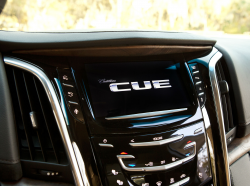— A Cadillac CUE screen lawsuit alleges the "Cadillac User Experience" infotainment screens crack, delaminate, bubble and become unresponsive.
The class action lawsuit includes current and former owners and lessees of these Cadillac vehicles equipped with CUE infotainment systems.
- 2013-2017 Cadillac ATS
- 2013-2017 Cadillac SRX
- 2013-2017 Cadillac XTS
- 2014-2017 Cadillac CTS
- 2014-2017 Cadillac ELR
- 2014-2017 Cadillac Escalade
Plaintiff Tonya Gruchacz purchased a new 2014 Cadillac ATS in New Jersey, but allegedly within the 4-year/50,000 mile warranty, the CUE screen allegedly became unresponsive.
The plaintiff says she called the dealership and was allegedly told the Cadillac was no longer covered by the warranty and it would cost about $1,200 to have the infotainment system repaired.
In July 2017, the CUE screen allegedly appeared cracked or shattered and was still unresponsive to touch, so the plaintiff called the dealership and was again told repairs would cost about $1,200.
Gruchacz says she brought the ATS to the dealer in March 2018 concerning an unrelated recall and she told them about the CUE screen appearing shattered and not responding to touch. According to the lawsuit, she was told by the dealership they “see this issue all the time. . .the screen is not cracked, it’s the laminate.”
The plaintiff was allegedly told it would cost $1,053.58 to repair the screen.
The class action lawsuit alleges General Motors sent technical service bulletins (TSBs) to dealers in December 2014 and August 2017 concerning the CUE screens appearing bubbled, cracked or delaminated. GM technicians were told to replace the "Integrated Center Stack,” which is the technical term for the CUE navigation/radio system.
According to the plaintiff, the 2014 bulletin refers to existing customer complaints, something which allegedly proves GM knew the systems were defective prior to 2014.
As for why the CUE touchscreens fail, the lawsuit alleges the adhesive film and glass become separated, or what some call, delaminated. The separation allegedly causes gaps between the electrode arrays causing electrical problems with the screens.
The plaintiff claims this is caused by faulty manufacturing of the sensing panel or by improper installation. Moisture allegedly enters into the interlayer because of the materials and causes failures of the bond due to faulty sealing during manufacturing.
"Poor interlayer bonding can also result from improper cleaning and preparation of the glass surface during panel manufacture resulting in delamination. Flawed installation of the panel in which clamping forces on the panel are excessive or of non-uniform nature can also contribute to delamination by generating strains, warping, and deformation in the glass that exceed the adhesive bond force of the interlayer." - Cadillac CUE lawsuit
General Motors allegedly should have known about CUE problems through internal testing and customer complaints about the screens and systems. In addition, the automaker allegedly conceals information about how the screens crack and delaminate just so GM can continue selling the vehicles.
The Cadillac CUE screen class action lawsuit was filed in the U.S. District Court for the District of New Jersey - Gruchacz, et al., v. General Motors, LLC.
The plaintiff is represented by Lite DePalma Greenberg, and Poulos LoPiccolo.
CarComplaints.com has complaints from drivers of the Cadillac vehicles named in the lawsuit.

